If You Dont Pee All the Way but Have to Pee Again
Introduction 
Millions of people in the United states of america struggle with Overactive Bladder (OAB) symptoms. The most common symptom is the ongoing urgent need to go to the bathroom. At present.
OAB can interfere with work, going out with friends, practise and slumber. It can lead y'all to the bathroom many times during the solar day or night. Some people leak urine (pee) after this urgent "gotta become" feeling. Others experience afraid they'll leak.
Fortunately, there is help and there are treatments.
What is OAB and Who Gets It? 
Overactive bladder is the proper name for a group of bladder symptoms. There are 3 chief symptoms:
- A feeling that you have to get to the bathroom, urgently.
- Sometimes incontinence, which means that you lot leak urine with the "gotta get" feeling.
- Normally the need to go to the bath often (frequently), day and night.
With OAB, you experience that you demand to empty your bladder – fifty-fifty when it's not full. This leads to the feeling that you need a bathroom apace, right at present. You can't control or ignore this feeling. (Although information technology may experience similar your bladder muscle is squeezing to empty your bladder, in actual fact your bladder muscle may not exist squeezing.) If yous "gotta go" eight or more times each day and night, or fright that urine volition leak out before y'all're ready, you lot may have OAB.
OAB affects about 33 million Americans. It's not a normal part of aging. It's a health trouble that tin concluding for a long fourth dimension if information technology's non treated. Many older men (xxx%) and women (xl%) struggle with OAB symptoms. Oft people don't know about treatments that can help, or they don't ask for help.
Stress urinary incontinence or SUI is a different float problem. People with SUI leak urine while sneezing, laughing or being active. It is not the same as that sudden "gotta go" feeling from OAB. To learn more virtually SUI, go to https://www.urologymanagement.org/sui/.
In this guide you will find clear information about how to manage OAB. Please enquire for assist, fifty-fifty if you feel embarrassed. Don't look, considering there are several treatments that work well for OAB. Your health intendance provider should be trained to talk with you and help you manage your symptoms without embarrassment.
For information about the other wellness care providers trained to help, click here.
How the Urinary Tract Works and What Happens with OAB 
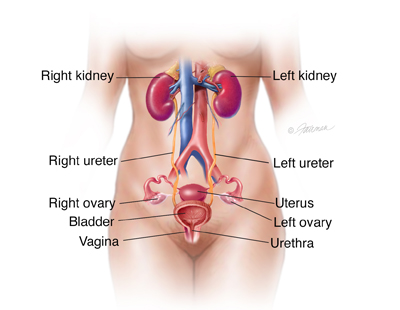
Urinary tract
Medical Illustration Copyright © 2015 Nucleus Medical Media, All rights reserved
The urinary tract is the important system that removes liquid waste matter from our bodies:
- kidneys: two edible bean-shaped organs that make clean waste matter from the claret and make urine
- ureters: 2 sparse tubes that take urine from the kidney to the bladder
- bladder: a balloon-like sac that holds urine until it's time to become to the bathroom
- urethra: the tube that carries urine from the bladder out of the body. The urethra has muscles called sphincters that lock in urine. The sphincters open to release urine when the bladder contracts.
When your float is total, your brain signals the float. The bladder muscles and then clasp. This forces the urine out through the urethra. The sphincters in the urethra open and urine flows out. When your bladder is not full, the float is relaxed.
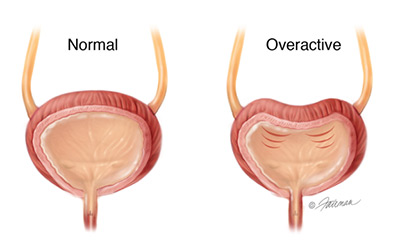
Bladder and sphincter
Image © 2003 Fairman Studios, LLC
With a salubrious bladder, signals in your brain let y'all know that your bladder is getting full or is full, only you can wait to go to the bath. With OAB, you can't await. You feel a sudden, urgent demand to go. This can happen even if your bladder isn't full.
Symptoms of OAB 
Urgency: This is the main symptom of OAB. It is a strong (urgent) demand to urinate that can't be ignored. This "gotta become" feeling makes people afraid that they'll leak urine if they don't discover a bathroom right away. OAB may also cause:
- Incontinence (urine leaks): Sometimes OAB causes urine to leak out earlier getting to the bathroom. This is chosen "urgency incontinence." Some people may leak just a few drops, while others can have a sudden gush. (for more data: https://world wide web.urologyhealth.org/urologic-conditions/urinary-incontinence)
- Urinate frequently: OAB may also crusade people to go to the bath many times during the solar day. Experts say that "frequent urination" is when yous have to go to the bathroom more than eight (eight) times in 24 hours.
- Wake upward at night to urinate: OAB can wake a person from sleep to get to the bath more than than once a dark. This is called "nocturia" by health providers.
Some foods and drinks tin can bother the bladder. Caffeine, artificial sweeteners, alcohol, chocolate and very spicy foods may make OAB symptoms worse.
OAB does non crusade pain. If you experience pain while urinating, you may take an infection. Delight talk with your health intendance provider near pain.
How OAB Tin can Affect Your Life 
Without treatment, OAB symptoms are uncomfortable. It tin be hard to go through the day without many visits to the bathroom. OAB can impact relationships. You may not want to do things you enjoy considering you worry about finding a bathroom in fourth dimension. Information technology can disrupt your slumber and sex life. It tin can leave you tired and curt-tempered, or leaks can atomic number 82 to a rash or infections. The whole feel can make anyone experience hopeless and very unhappy.
The skilful news is that OAB can be controlled. At that place are treatments available to aid.
Finding the Words 
It'southward normal to feel uncomfortable when talking near OAB symptoms. Who wants to talk about bathroom problems or incontinence?! Still, knowing more about OAB is the best way to have control of the trouble. A trivial planning will requite you confidence. Hither are some tips to assistance:
- Be prepared: Before your date, gather useful data to help the wellness intendance provider acquire what's going on. Also be set up to have notes about what you lot larn. Bring:
- A listing of the prescription drugs, over-the-counter medicines, vitamins and/or herbs you take.
- A list of your by and current illnesses or injuries.
- Results from the Recall You Accept Overactive Bladder? Quiz , to help you discuss your symptoms.
- A pad of newspaper and pen to take notes nearly treatments
- Bring a friend: Ask a close friend or relative to go with you to the doctor, if you don't mind sharing what's going on. An "date buddy" tin assistance remind y'all of things y'all may forget to ask, or remind you of things the health care provider said.
- Bring upwardly the topic: If your health care provider doesn't ask about your OAB symptoms, bring up the topic yourself. Don't wait until the end of your visit. Make sure you take time for questions. If a nurse meets with you lot first, tell the nurse about your symptoms.
- Speak freely: Share everything y'all're experiencing. Your wellness care provider hears virtually problems every twenty-four hours. They've heard it all! Information technology's OK to tell them near your symptoms and how they touch your daily life. Let your health care provider know your answers to these questions:
- Do my symptoms make me terminate doing the things I enjoy, or prevent me from going to events?
- Am I afraid to be too far abroad from a bathroom?
- Have my symptoms changed my relationships with friends or family?
- Practice my symptoms make it hard to get a good dark'southward sleep?
- Ask questions: A visit to your health care provider is the right fourth dimension to ask questions. It is best to bring your list of questions with you and so you don't forget. We offer some good question to ask in each department of this guide to help you.
- Follow-up intendance: Enquire your health intendance provider when you should visit once again, and what you should bring with you lot.
How to Diagnose OAB 
When y'all tell your health care provider almost your symptoms, s/he will ask more than questions and do some tests. This is done to diagnose the problem. OR, your provider will tell you the name of a specialist who can diagnose and treat you.
To learn what's happening, a wellness care provider will likely:
- Ask about your health history: Y'all will be asked about how you feel, how long y'all've had symptoms, and how they touch you lot. You volition be asked about medicine y'all accept (over-the-counter and prescribed). You should besides talk about what you eat and beverage during the mean solar day. This lets your provider learn about your health at present and in the past.
- Exercise a physical exam: Your health care provider volition look for things that could cause symptoms. In men and women, they will feel your organs in and below your belly, in your pelvic area. They volition also check your rectum.
- Inquire y'all to proceed a "Bladder Diary:" A Bladder Diary helps you, and your dr., learn well-nigh daily events and patterns. In this diary you write down how often yous go to the bathroom and if/when you leak urine. You can use this Bladder Diary sample to start. You can also download an electronic float diary for your mobile device similar The Float Pal. This app was adult by AUA Fellow member, Dr. Ronald Yap, through the support of the LeBaron Foundation and the Hold Hospital Trust.
- Bladder Pal app for Android
- Float Pal app for Apple
- Practice other tests if you need them:
- Urine test: a sample of your urine may be tested for infection or blood.
- Bladder scan: This examination shows how much urine is left in your bladder after yous go to the bathroom.
- Cystoscopy: Your health care provider inserts a thin tube with a tiny camera into the float to see if information technology looks normal or not.
- Urodynamic testing: These tests check to meet how well your lower urinary tract holds and lets-go of urine. One of these tests is telephone call CMG (cystometrogram ).
- Symptom quiz: Many doctors use a written quiz to ask questions about your bladder problems and what causes you the most carp. Take our OAB Quiz
At that place are a number of things you tin can do to help manage OAB. Everyone has a different feel with what works all-time. You lot may try one treatment alone, or several at the same fourth dimension. You and your health care provider should talk about what you want from treatment and about each option.
OAB treatments include:
Lifestyle Changes 
To manage OAB, wellness care providers offset inquire a patient to make "lifestyle changes". Sometimes these changes are called "behavioral therapy". This could mean that you eat different foods, change how much, when or what you drink, and pre-plan bath visits to experience amend. Many people notice that these changes assist. Other people demand to exercise more.
- Limit nutrient and drinks that bother your bladder: Many people feel better when they modify the way they eat and drink. There are certain foods known to carp the bladder. You can endeavor taking all of these things out of your diet, then add them back ane at a fourth dimension. One time you larn which foods and drinks brand your symptoms worse, you lot tin avert them. Common foods to avoid:
- Java / caffeine
- Tea
- Artificial sweeteners
- Alcohol
- Soda and other fizzy drinks
- Citrus fruit
- Food made with tomatoes
- Chocolate (non white chocolate)
- Spicy foods
- Continue a bladder diary: Writing down when you make trips to the bathroom for a few days can aid yous understand your body meliorate. This diary may evidence you things that make symptoms worse. For example, are your symptoms worse after eating or drinking a certain kind of food? Are they worse when you don't drink enough liquids?
- Double voiding (emptying your bladder twice): This may be helpful for people who have problem fully emptying their bladders. After you go to the bathroom, you wait a few seconds and and so try to become again.
- Delayed voiding: This means that y'all practice waiting before you go to the bathroom, even when you take to go. At first, y'all expect just a few minutes. Gradually you may be able to expect two to three hours at a time. Just try this if your health care provider tells you to. Some people feel worse or take urine leaks when they await besides long to go to the bathroom.
- Timed urination: This ways that y'all follow a daily bathroom schedule. Instead of going when you feel the urge, you go at set times during the twenty-four hour period. Yous and your wellness intendance provider will create a reasonable schedule. Yous may endeavor to urinate every 2 to four hours, whether you feel you have to go or not. The goal is to prevent that "urgent" feeling and to gain control.
- Exercises to relax your float muscle: You may exist familiar with exercises to strengthen your pelvic floor muscles, as well chosen Kegel exercises. A special do using those aforementioned pelvic floor muscles may aid relax your float during those "gotta go" moments. To do "quick flicks," you chop-chop clasp and relax your pelvic floor muscles repeatedly. When yous feel the urge to become, try a number of "quick flicks" instead. These exercises can assistance control that "gotta get" feeling. It helps to be still, relax and focus on just the do. Your wellness intendance provider or a physical therapist tin can help you larn these exercises. Biofeedback may likewise assistance. Biofeedback uses calculator graphs and sounds to monitor muscle movement. It tin help teach you how your pelvic muscles move and how strong they are.
Prescription Drugs 
When lifestyle changes aren't enough, the next step may be to take medicine. Your health intendance provider can tell you almost special drugs for OAB.
In that location are several types that can relax the float muscle. These drugs (for example: Anti-muscarenics and Beta-3 agonists) can help finish your bladder from squeezing when information technology's non full. Some are taken every bit pills, by mouth. Others are gels or a sticky patch to give yous the drug through your skin.
Your health intendance provider will desire to know if the medicine works for you lot. They will check to see if y'all get relief or if the drug causes problems, known as "side-effects". Some people become dry out oral cavity and dry optics, constipation, or blurred vision.
To assistance relieve symptoms, your health intendance provider may ask you to have dissimilar amounts of the drug. Or, requite yous a different one to try. Yous may be asked to make lifestyle changes and accept medicine at the aforementioned time for better results.
Injections 
If lifestyle changes and medicine aren't working, at that place are other options. A trained urologist or FPMRS specialist tin help. They may offer bladder injections (shots) of Botox® (botulinum toxin).
Small amounts of Botox® can stop the float muscles from squeezing too much. Many tiny injections are used. Information technology gently paralyzes the muscles. Additional treatments are given when this treatment wears off, anywhere from vi to twelve months later. Your doc volition lookout how you're doing to brand sure you aren't retaining (property in) too much urine. If urine is non draining well, you may need to catheterize temporarily.
Nerve Stimulation (Neuromodulation Therapy) 
Some other treatment for people who need extra assist is nerve stimulation, also chosen neuromodulation [pronounced: NER-oh-mahd-yoo-LAY-shun] therapy.
This type of treatment sends electric pulses to fretfulness in your bladder. In OAB, the nerve signals between your float and brain don't work the correct style. These electric pulses interrupt the nerve signals, fix them correct, and improve OAB symptoms.
In that location are two types:
- Sacral neuromodulation (SNS) changes how the sacral nervus works. This nervus carries signals between the spinal cord and the bladder. Its job is to assistance concord and release urine. In OAB, these nervus signals aren't doing what they should. SNS uses a "float pacemaker" to command these signals to stop OAB symptoms. SNS is a two-step surgical process. The first step is to implant an electric wire under the pare in your lower back. This wire is outset connected to a handheld "pacemaker" to send pulses to the sacral nerve. You lot and your dr. will test whether or not this pacemaker tin help you lot. If it helps, the second step is to implant a permanent pacemaker that tin can regulate the nerve rhythm.
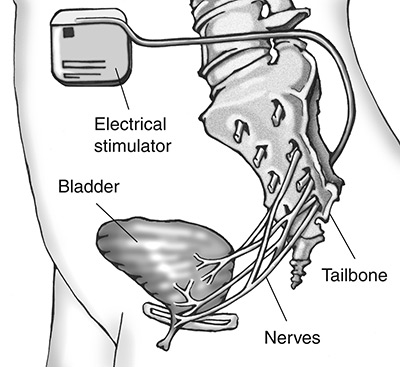
Sacral neuromodulation (SNS)
National Institute of Diabetes and Digestive and Kidney Diseases,
National Institutes of Health - Percutaneous tibial nervus stimulation (PTNS) is another way to correct the nerves in your float. For this type of nerve stimulation y'all volition not have to take surgery. PTNS is performed during an office visit that takes well-nigh 30 minutes. PTNS is done by placing a small electrode in your lower leg virtually your talocrural joint. It sends pulses to the tibial nerve. The tibial nerve runs along your knee to the sacral nerves in your lower back. The pulses help command the signals that aren't working right. Often, patients receive 12 treatments, depending on how it'due south working. [This therapy is pronounced: PER-cyoo-TAY-nee-uhs TI-bee-ahl NERV STIM-yoo-LAY-shun.]
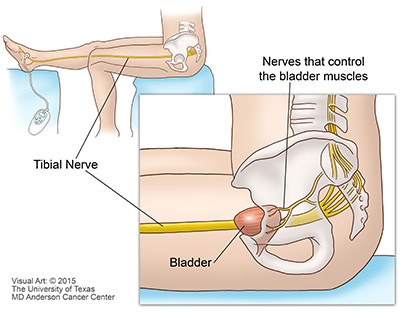
Percutaneous tibial nerve stimulation (PTNS)
(c)2012 The University of Texas M.D. Anderson Cancer
Other Resources 
Here are a few more than organizations that offer useful information to assist people living with OAB and incontinence.
Urology Care Foundation
1-800-828-7866
The official foundation of the American Urological Association, the Urology Intendance Foundation is committed to advancing urologic research and education. We collaborate with researchers, wellness intendance providers, patients and caregivers to improve patients' lives.
American Urological Association
The American Urological Clan promotes the highest standards of urological clinical care through instruction, research and health intendance policy.
Information technology'due south Fourth dimension to Talk about OAB
Become the facts. Get diagnosed. Take command.
Society printed materials most OAB, take our "Overactive Bladder Quiz," and download a "Bladder Diary" to track your symptoms.
It'southward Time to Talk almost SUI
Find out more almost Stress Urinary Incontinence, order printed materials and take the SUI quiz.
National Kidney and Urologic Diseases Clearinghouse:
The National Kidney and Urologic Diseases Information Clearinghouse (NKUDIC) is a service of the National Plant of Diabetes and Digestive and Kidney Diseases (NIDDK) that provides information on kidney and urologic diseases. The NIDDK is part of the U.S. National Institutes of Wellness (NIH).
National Clan for Continence
The National Association for Continence is a national, private, not-turn a profit organisation dedicated to improving the quality of life of people with incontinence, voiding dysfunction, and related pelvic flooring disorders. NAFC'due south purpose is to be the leading source for public teaching and advocacy almost the causes, prevention, diagnosis, treatments, and management alternatives for incontinence.
Simon Foundation for Continence
The mission of the Simon Foundation is to bring the topic of incontinence out into the open, remove the stigma surrounding incontinence, and provide assist and hope to people with incontinence, their families and the health professionals who provide their intendance.
Patient resources provided through the generous support of:
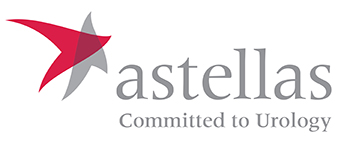
Source: https://www.urologyhealth.org/overactive-bladder
0 Response to "If You Dont Pee All the Way but Have to Pee Again"
Post a Comment